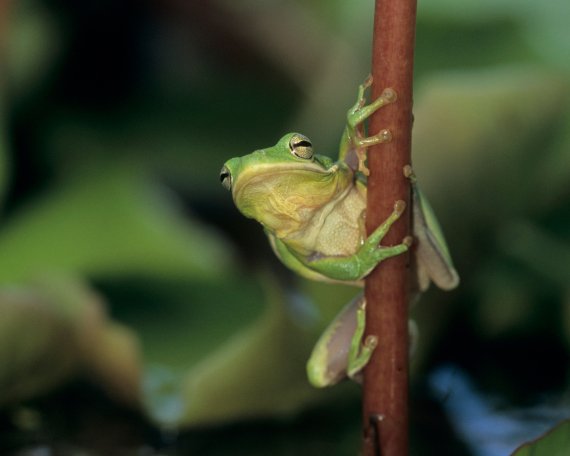Tree frogs have been fascinating scientists around the world for a long time. How is it possible that these creatures, with their inherently wet feet, seem to climb without effort. What causes the adhering force that enables them to stick even to wet and inverted surfaces? And above all: could we humans use these principles to our advantage?
Subcutainious
The German researcher Julian Langowski (Experimental Zoology Group) has lifted a good part of the veil. He obtained his PhD (cum laude) for his dissertation splendidly entitled “Getting a grip on tree frog attachment”. He mainly focused on the subcutaneous structures of the frogs’ adhesive toe pads, which were largely terra incognita. But according to Langowski, studying internal structures helps a lot to understand how the frogs can adhere so well.
The morphology of the foot indicates a significant role for friction and van der Waals forces
Julian Langowski
‘The surface of the pads is important, of course, because that is where the interaction with the substrate takes place’, Langowski says. ‘But what also comes into play is how the adhesive surface is connected to the rest of the animal. The internal mechanics are an important part of attachment too.’ With the help of classical histological methods (tissue colouring) and modern computer-tomography, Langowski and colleagues mapped out the internal structure of the sticky frog digits in 3D.
Connective tissue
A layer of connective tissue that links the epidermis of the pads to the finger bones turned out to be crucial. This connective tissue appears to be oriented in such a way that it reinforces the pads primarily against frictional loads which act on a frog hanging on a vertical surface. According to Langowski, this is an important indication of the adhesive mechanism.
The skin of tree frogs is wetted by mucus. Until now, the adhesive ability of tree frog feet was mainly attributed to wet adhesion, in which capillary action plays an important part. The surface structure of the adhesive pads would seem to support this at first glance. The pads consist of a pattern of small hexagonal pillars (10 micrometres in diameter), which in turn are covered with pillars at the nanoscale (0.3 micrometres).

van der Waals forces
The spaces between the pillars, filled with mucus, ensure a capillary effect and thus adhesion. But such capillary forces only work perpendicular to the surface. How does that tie in with the subcutaneous collagen that seems to take up forces parallel to the surface? It does not, Langowski argues. But van der Waals forces could explain the shape of the collagen layer.
Langowski: ‘I am not implying that wet adhesion does not occur, but the morphology of the foot indicates a significant role for friction and van der Waals forces.’ In that view, the pillars provide a drainage structure. ‘When setting the foot down, the layer of mucus is squeezed out through the channels between the pillars, to allow as close contact as possible. Van der Waals forces act over small distances (<5-10 nanometres). Such small gap widths have been measured for frog toes in contact with a substrate.’
Smoothe muscle fibres
During his research, Langowski made another important discovery. ‘The pads contain smooth muscle fibres. This is unique among sticky animals, as far as I know. It means there is an active element the animals can use to manipulate their attachment. We don’t know yet how that works, but tree frogs might be able to control the distribution of stress over the contact surfaces.’
A highly adhesive surface is nice but useless if the underlying structure can’t handle the forces.
Julian Langowski
Langowski’s results may lead to new design principles for biomimetic adhesives and grippers. The study of the feet of tree frog and other biological gripping systems will eventually lead to bioinspired devices instruments that allow to gently manipulate fragile objects with various surfaces in a wet environment. Instruments for minimal invasive surgery, for example, or grippers for harvesting robots that work with fruit and vegetables.
Useless
‘In this context, the structure of the surface is important’, Langowski says. ‘We need to answer the question which surface pattern provides the optimal grip. In addition, my work shows that the material’s internal structure also is crucial. I expect that in the future, bioinspired adhesives with internal fibre-reinforcement will become more and more important. A highly adhesive surface is nice but useless if the underlying structure can’t handle the forces.’

 Wet adhesion cannot fylly explain the adhesive capability of frogs’ feet, says Julian Langowski. Photo: Shutterstock
Wet adhesion cannot fylly explain the adhesive capability of frogs’ feet, says Julian Langowski. Photo: Shutterstock